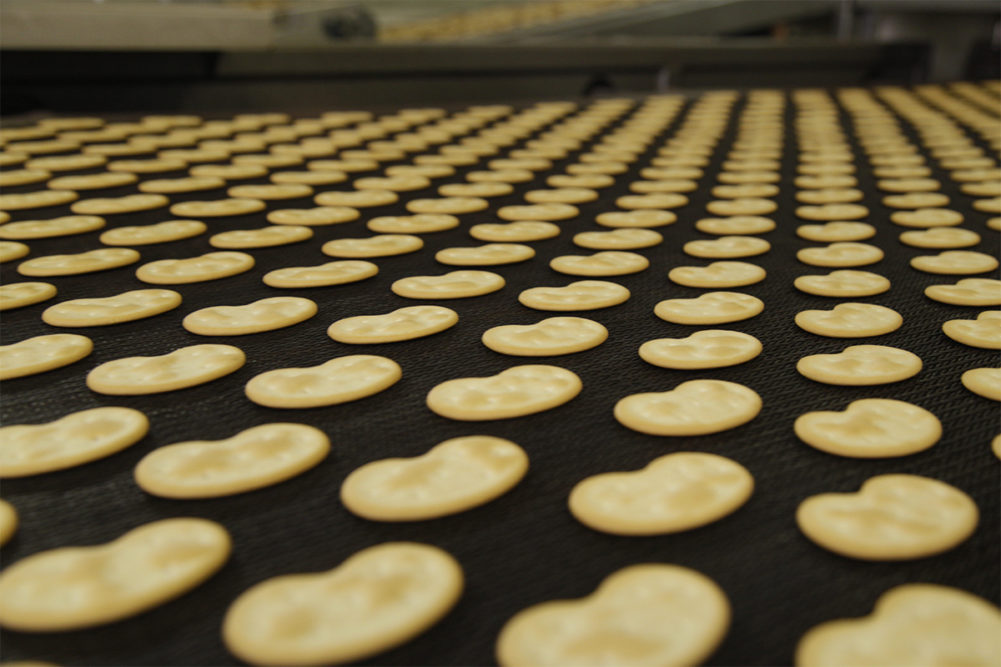Fermentation time may be a critical moment for leavening and flavor development for yeast-leavened crackers, but the product isn’t home free quite yet. After fermentation, cracker dough is sent through the makeup equipment to be sheeted and laminated and cut into its final shape. At this stage, the dough must be treated gently to ensure that the gluten isn’t damaged while also reducing the dough sheet enough to get the proper, even bake in the oven.
A properly mixed and fermented dough goes a long way to ensuring the sheeting and laminating process goes well. Any issues that occur between these gauge rollers won’t show up until the product is baked and cooled, so it’s imperative that the sheeting line is designed properly to get the right amount of reduction at each stage in the process while not harming the dough sheet. Otherwise, bakers will lose entire batches of finished product before realizing a change needs to be made.
Dan Christie, account manager, Spooner Vicars, a Middleby Bakery company, has noticed two trends in makeup line design to address these issues and prevent waste. Both result in a longer production line but improve accessibility and reduce stress on the dough.
“I’ve noticed a lot of bakers are taking the four-roll sheeter off from the laminators and putting it on the ground level,” he said. “This takes up more floorspace, but it provides a better visual to see that the sheet is good. It also makes the equipment more accessible. Operators can see what’s going on, see that they’re getting a good product and make corrections accordingly.”
After this initial dough reduction, the dough will typically go through three gauge rollers to reduce the sheet to its final thickness. Each gauge roller puts more work and stress into the dough to help it achieve that final required thickness, which increases the likelihood of damage being imparted to the dough sheet. This can negatively impact the final product characteristics.
To relieve some of that tension, Mr. Christie is seeing more bakers add a fourth gauge roller. While this also extends the length of the production line, it takes some of the pressure off that final gauge roller to carry the dough sheet to the finish line.
“After laminating, the gauge rollers will reduce the dough sheet’s thickness by about 50% at each roller,” Mr. Christie explained. “When you get to the tail end of the rollers, there’s more work to do, and there’s a lot of work on the final gauge roller to meet that final reduction without product damage. By adding the fourth gauge roller, you can put less stress on the dough and ensure the quality is consistent.”
To address this, Spooner Vicars developed robust gauge rollers at 400 mm, which can eliminate the need for a fourth gauge roller.
The final steps in the cracker production process are baking and cooling, the moment of truth. It’s here where bakers will discover if the mixing, fermenting and makeup steps were correctly executed, and it’s also the last chance for error. The bake is all about timing and control, and at this step, the answer to efficiency and quality may not be what bakers expect.
“While this may seem counter-intuitive, increasing the baking time slightly can help with line efficiency,” said Don Smith, director, engineering sales and service, Reading Bakery Systems (RBS). “Trying to bake a product as fast as possible sometimes creates inefficiency in the packaging process and causes a lot of waste. Increasing the bake time slightly will often help with the overall product quality and reduce the speed of the packaging equipment, thus increasing the efficiency of the line.”
That’s because bakers run the risk of checking, or crackers that break after they are cooled and packaged, if their ovens operate hot and fast. The cracker will crust over too quickly, not allowing all the moisture to leave the product during the bake. The moisture left in the cracker will cause cracks and breaks to occur once it is cooled. It can also happen if bakers don’t devote enough time to cooling.
“Quite often bake times are decreased to increase throughput, but customers often overlook correct cooling and conditioning time and the space required to ensure the product is in the correct condition when arriving at the packaging machine,” explained Kevin Knott, technical sales manager, Bühler Group.
Conditioning, which happens after the bake and before packaging, equalizes the moisture in the product. Rushing this process to produce more crackers in the name of efficiency can actually result in a greater amount of product lost.
Today’s ovens also offer bakers a new level of control of their bake, minimizing the opportunities for things to go wrong.
“The advent of the hybrid oven brings much more consistency and control of the overall baking process, and the convection portion in the latter part of the bake helps with the reduction of product checking,” Mr. Knott said. “The control of bake chamber humidity also brings a new level of overall process control, resulting in better consistency of product quality.”
Without this level of control, bakers run the risk of high-moisture content, improper stack height and even the color at the end of the process.
This article is an excerpt from the August 2022 issue of Baking & Snack. To read the entire feature on Cracker Processing, click here.





